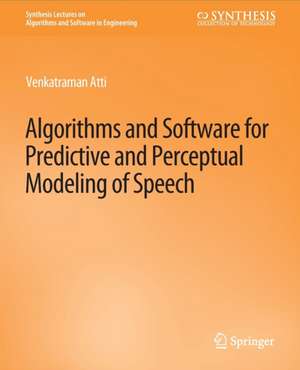Algorithms and Software for Predictive and Perceptual Modeling of Speech: Synthesis Lectures on Algorithms and Software in Engineering
Autor Venkatraman Attien Limba Engleză Paperback – 28 mar 2011
Din seria Synthesis Lectures on Algorithms and Software in Engineering
-
 Preț: 380.37 lei
Preț: 380.37 lei -
 Preț: 260.95 lei
Preț: 260.95 lei -
 Preț: 384.31 lei
Preț: 384.31 lei -
 Preț: 351.11 lei
Preț: 351.11 lei -
 Preț: 262.47 lei
Preț: 262.47 lei -
 Preț: 206.29 lei
Preț: 206.29 lei -
 Preț: 192.63 lei
Preț: 192.63 lei -
 Preț: 206.29 lei
Preț: 206.29 lei -
 Preț: 192.05 lei
Preț: 192.05 lei -
 Preț: 204.76 lei
Preț: 204.76 lei -
 Preț: 204.76 lei
Preț: 204.76 lei -
 Preț: 379.48 lei
Preț: 379.48 lei -
 Preț: 414.65 lei
Preț: 414.65 lei -
 Preț: 192.41 lei
Preț: 192.41 lei -
 Preț: 389.88 lei
Preț: 389.88 lei -
 Preț: 205.92 lei
Preț: 205.92 lei -
 Preț: 260.56 lei
Preț: 260.56 lei -
 Preț: 207.83 lei
Preț: 207.83 lei -
 Preț: 266.70 lei
Preț: 266.70 lei -
 Preț: 381.43 lei
Preț: 381.43 lei
Preț: 261.91 lei
Nou
Puncte Express: 393
Preț estimativ în valută:
50.12€ • 51.78$ • 41.71£
50.12€ • 51.78$ • 41.71£
Carte tipărită la comandă
Livrare economică 26 martie-09 aprilie
Preluare comenzi: 021 569.72.76
Specificații
ISBN-13: 9783031003882
ISBN-10: 3031003888
Ilustrații: IX, 113 p.
Dimensiuni: 191 x 235 mm
Greutate: 0.23 kg
Editura: Springer International Publishing
Colecția Springer
Seria Synthesis Lectures on Algorithms and Software in Engineering
Locul publicării:Cham, Switzerland
ISBN-10: 3031003888
Ilustrații: IX, 113 p.
Dimensiuni: 191 x 235 mm
Greutate: 0.23 kg
Editura: Springer International Publishing
Colecția Springer
Seria Synthesis Lectures on Algorithms and Software in Engineering
Locul publicării:Cham, Switzerland
Cuprins
Introduction.- Predictive Modeling of Speech.- Perceptual Modeling of Speech.
Notă biografică
Atti Venkatraman, PhD, is a Staff Engineer at Verance Corporation. His work focuses on the development of robust and advanced watermarking algorithms for digital cinema. Prior to Verance Corporation, he was with Acoustic Technologies, where he focused on the research and development of perceptually-based algorithms for acoustic echo cancellation, noise reduction, and audio enhancement for both cellular handset and telematics solutions. He has worked extensively on integrating perceptual signal processing methods in linear prediction. He has also contributed heavily to advanced distance learning technologies involving Java.
